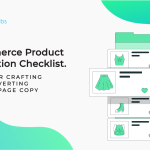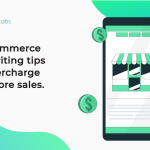
OK. We’re going to level with you here.
The phrase ‘email automations’ might not be the most thrilling combination of words.
But stay with us on this one.
For e-commerce businesses looking to consistently increase online store revenue and maintain valuable customer relationships, email marketing can be an incredibly powerful tool.
For one thing, ecommerce email marketing is proven to be extremely efficient, generating an average of $42 for every $1 invested.
No need to double-take. You read that correctly.
And not only is ecommerce email marketing hugely profitable, but it can also be effectively automated to deliver optimal results.
Why is that important? Well, time is a limited resource for most e-commerce businesses.
Email marketing allows you to deliver maximum returns with minimal effort. With the right setup and strategy, you can just launch your email campaigns and watch the magic happen.
(Bet email automations sound a little more interesting now, eh?)
To help you get started, we’ve pulled together everything you need to know about running insanely effective email marketing campaigns – including 9 tactical automations (with ecommerce email examples) that are designed to turbocharge your revenue.
What are email automations, exactly?
The idea behind automated ecommerce email marketing campaigns is fairly simple.
Email campaigns are an excellent way of communicating with your target audience. They’re simple to launch, deliver a strong ROI, and are highly versatile.
But there’s one minor issue.
Manually emailing every single one of your customers would be incredibly time-consuming, if not completely impossible.
And you’ve got plenty of other things to do beyond writing personalised promotional email templates. You know, stuff like running a successful ecommerce business.
So what’s the answer?
Bingo. Email automations.
Email automations allow businesses to capitalise on all of the benefits of ecommerce email marketing, without having to craft every individual message.
These email communications are built around set templates and designed to target different customers, events and touchpoints. Once the templates are created and the email marketing strategy is ready, these automations can be deployed instantly.
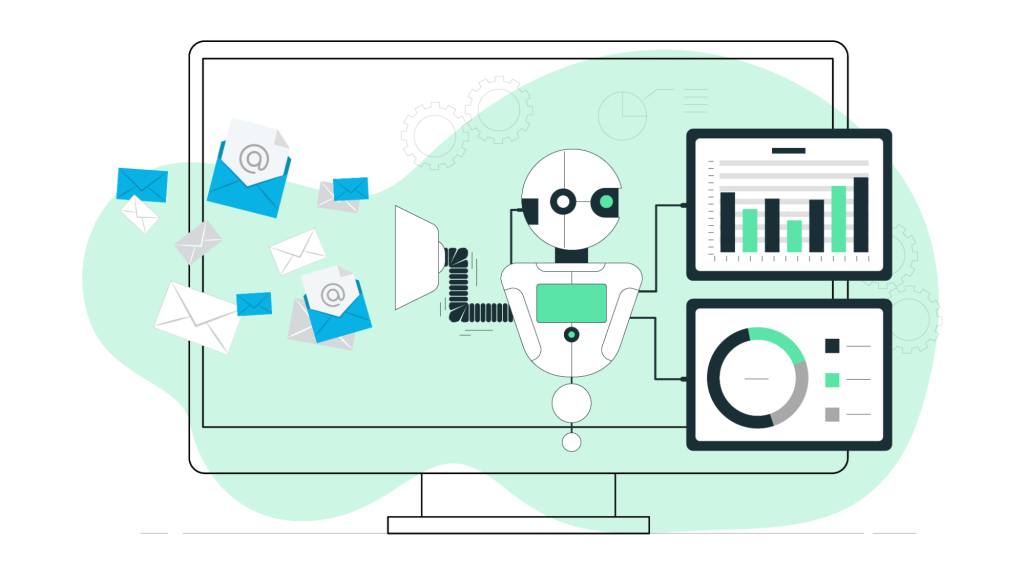
Why are email automations so useful?
Email automations are hugely valuable for a few reasons.
Firstly, email marketing campaigns feel uniquely personalised for your target audience, but can also be launched at scale.
Tailored marketing messages are always more relevant and effective, so the ability to deliver them en masse is extremely useful.
Secondly, email marketing is a blessing for busy ecommerce business owners.
Not only are these automated messages delivered tactically to maximise returns, but they also free up a huge amount of time in your diary, allowing you to focus on other tasks.
Finally, email marketing campaigns are proven to consistently deliver results, and the e-commerce statistics show it.
Marketers using properly segmented email automations have seen as much as a 760% increase in revenue. That’s a difficult number to beat when it comes to marketing efficiency.
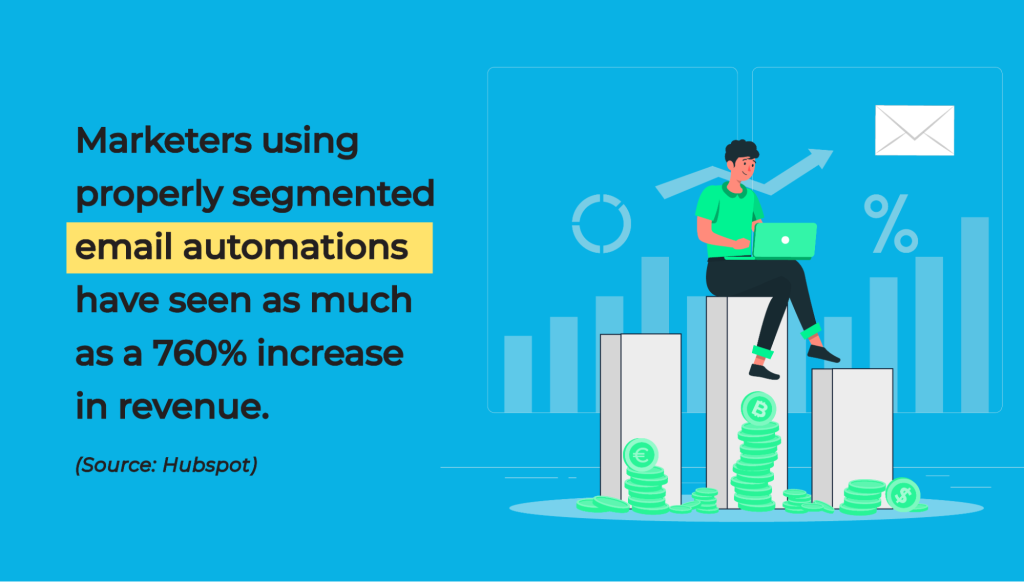
9 incredibly effective email automations
There are several different types of campaigns that fall under the ‘email automations’ umbrella.
Different automated sequences can be activated based on specific types of customers, specific online events and specific digital touchpoints.
Your messaging and tactics will change based on the ecommerce email marketing sequence that you’re running.
If you can master a range of different ecommerce email automations, you maximise the number of opportunities you have to generate revenue and drive conversions.
Let’s take a look at 9 of the most potent ecommerce email automations, highlight the differences between them, and explain how you can make the most of them.
1. The ‘Welcome Flow’
If a new prospect has subscribed to your mailing list, this is a vitally important moment for your business.
Capturing email data and contact details is great, but you need to ensure that any new subscribers are swiftly converted into future customers.
A Welcome email automation is the perfect tactic to achieve this goal.
It’s your first direct correspondence with a potential customer, sent promptly once they’ve subscribed to your promotional emails. Think of a Welcome email like any other introduction – it’s the chance to make a good first impression.
What are the benefits of a Welcome Flow?
An individual obviously has some interest in your business if they’ve subscribed to a mailing list, so you need to follow up swiftly and transform this curiosity into action.
A solid Welcome email can assist you in a few ways.
Firstly, it’s a great opportunity to introduce your business and set out your stall. You can communicate your brand values and outline your core offering.
This is a brilliant way to get customers excited about your business and products.
Secondly, you can immediately start to incentivise a new purchase.
Although you want to avoid an aggressive Welcome email that feels like a forced sales pitch, you can still begin to nurture a new customer relationship with tactical messaging.
What makes for an effective Welcome email?
A Welcome email series can include different messages, but it ultimately needs to make customers feel excited and positive about your business offering.
Here’s one example of a solid Welcome email from The Body Shop:

There are a lot of smart ecommerce email marketing tactics included here.
New subscribers are treated to an immediate discount (who doesn’t love a sales promotion?) while the quote alludes to the character and personality of the brand.
Users are also presented with two CTAs. They can learn more about the business, or get shopping immediately, which is a nice low-pressure choice for fresh subscribers.
Below is another effective Welcome email example from Lyft:

Sometimes a simple soft sell is best when it comes to Welcome Flow email templates.
Lyft delivers an introductory email that contains bright, clean visuals and an upbeat message. New subscribers immediately feel welcomed, without any sales-y messaging.
A concise and clearly highlighted CTA also guides users in the right direction, without any pressure or obligation. It’s a simple but effective Welcome email that nails the basics.
Here’s another strong Welcome email automation from L’Occitane:

This Welcome email ticks all of the right boxes.
Firstly, L’Occitane lays out some of its core brand principles, like using natural ingredients and working with local producers.
Secondly, there are clear incentives for a purchase.
An enticing introductory discount code for new subscribers is included, as well as some impactful social proof in the form of product testimonials.
The email perfectly balances Welcome email messaging with persuasive nudges toward a sale.
2. The ‘Cart Abandonment Flow’
Many users will add your products to their online shopping carts, but ultimately leave your online store without converting.
It’s a tragic fact. But a fact nonetheless.
But there’s no need to lose hope.
A Cart Abandonment Flow is an email marketing series designed to nudge shoppers back to their cart and secure a successful conversion.
You can send multiple Cart Abandonment Flows at different intervals, and it’s important to experiment with timings to understand which works best.
There’s no one-size-fits-all answer!
What are the benefits of a Cart Abandonment Flow?
There are plenty of legitimate reasons for users to abandon their shopping carts.
(Don’t take it personally.)
But a tactical Cart Abandonment Flow allows you to tackle some of the most common reasons for abandonment and recover this previous revenue.
You can address potential customer objections, offer persuasive discount codes, and reiterate the benefits of your products.
A huge amount of profit can be lost through abandoned carts, so if you can successfully retrieve even a small percentage of this revenue, you’ll be in a fantastic position.
What makes for an effective Cart Abandonment Flow?
Successful Cart Abandonment email templates need to anticipate (and remove) the objections a user might have to complete a purchase.
Here’s an effective Cart Abandonment Flow from Dyson:

The email provides users with all the motivation they need to complete a purchase.
There are two clear CTAs to restore the cart, a limited-time promotion is referenced to create urgency, the abandoned products are clearly showcased, and ‘reasons to shop at Dyson’ are emphasised.
Below is another solid Cart Abandonment Flow from Whisky Loot:

This is a prime example of addressing potential customer objections to secure a conversion.
The email lists all of the reasons a customer will benefit from a Whisky Loot box, and the humorous tone makes the entire message feel endearing and authentic.
The email also contains an informative Q&A section with a clear CTA, reminding the customer of everything they’ll miss out on if they don’t complete the purchase.
Here’s another creative Cart Abandonment Flow from Casper:

This is a simple Cart Abandonment campaign, but it’s masterfully crafted.
The messaging is clear, and instantly reminds shoppers of their basket contents. Users can quickly navigate back to their abandoned cart with a single click.
The inclusion of social proof is also highly effective. A simple customer testimonial that speaks volumes about the quality of the Casper products.
3. The ‘Browse Abandonment Flow’
Not every user will make a purchase after their first visit to your ecommerce site.
They might just be browsing your products out of curiosity, or testing the waters to compare your offering against competitors.
Luckily, you don’t need to sit and wait for these users to make a decision.
A Browse Abandonment Flow is an email sent to users who have taken specific actions on your ecommerce site without making a purchase.
They might have landed on your home page or opened a specific product category.
Whatever the case, you can retarget them with tailored email marketing to keep them engaged.
However, it’s important to note the difference between a Browse Abandonment Flow and a Cart Abandonment Flow.
When a user has filled and abandoned their cart, they’ve shown a higher level of purchase intent than a user who’s just visited your website. Your email marketing should reflect this!
What are the benefits of a Browse Abandonment Flow?
Although a visitor landing on your website isn’t a huge indicator of purchase intent, it does open up a great opportunity to establish a customer relationship.
A Browse Abandonment email allows you to capitalise on a landing page visit and keep your brand top-of-mind for potential customers.
By finding creative ways to re-engage website visitors, you can push them through the sales funnel and transform website clicks into more sales.
What makes for an effective Browse Abandonment Flow?
An impactful Browse Abandonment Flow ultimately needs to be interesting, engaging, and direct.
Since a user hasn’t taken a significant action that can be leveraged (i.e. a checkout click or sale) the Browse Abandonment messaging needs to work even harder to reignite interest.
Here’s a good example of an effective Browse Abandonment Flow from ASOS:
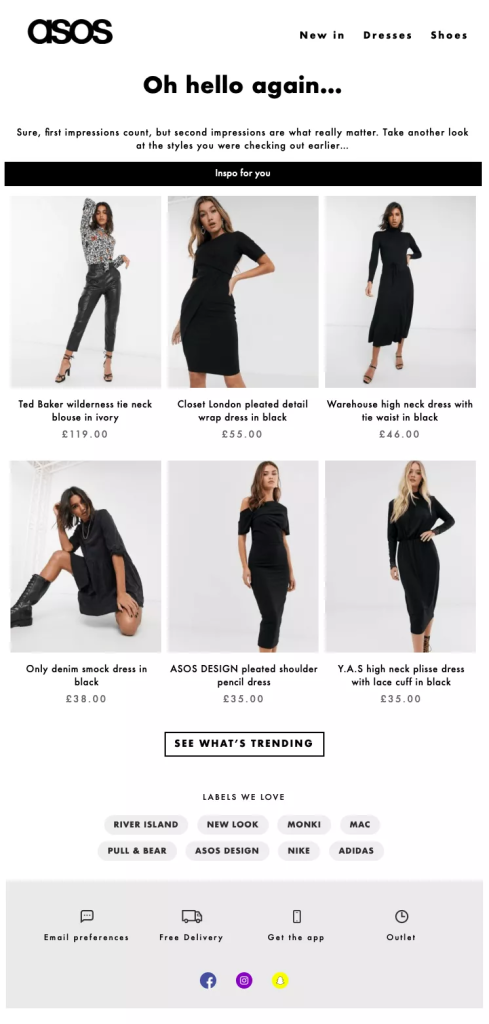
The messaging used here is deliberately casual and relaxed, inviting users to continue browsing ASOS products at their leisure.
Since Browse Abandonment users haven’t added a specific item to their cart, ultra-aggressive sales messaging isn’t particularly effective.
ASOS also cleverly references making a ‘second impression’ with these promotional emails. This kind of self-awareness helps the email to feel more genuine and less like a sales tactic.
Below is another tactical Browse Abandonment Flow from Aerosoles:
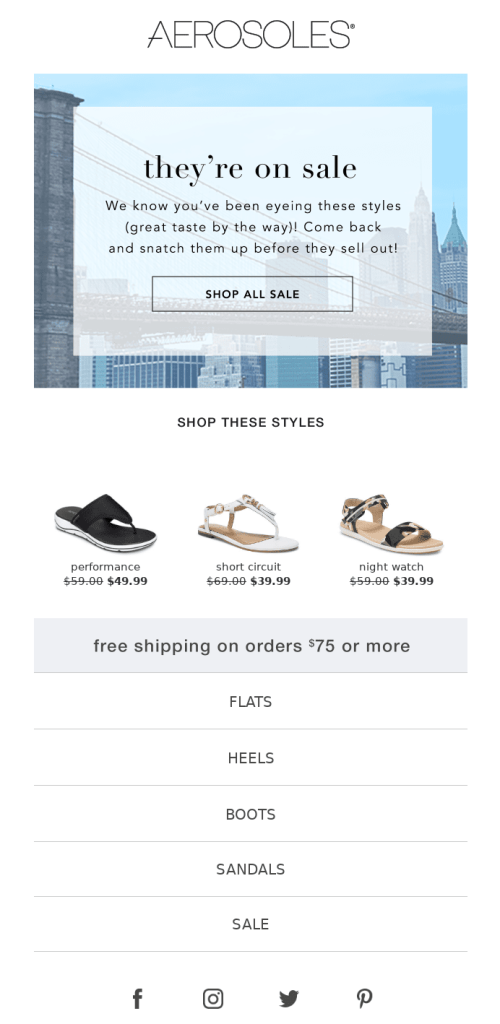
This is a good example of Browse Abandonment email marketing fuelled by a more direct sales message.
The email acknowledges the browsing behaviours of the user (making the email feel immediately relevant) and swiftly follows up with an urgency-driving sales promotion.
Not every Browse Abandonment series needs to push a quick purchase, but recognising products that shoppers are interested in (and offering them a discount) is a powerful email marketing strategy that’s likely to boost sales.
Here’s a highly effective Browse Abandonment email from Debenhams:

This email contains all the essentials for a successful Browse Abandonment campaign.
The message reminds users of the specific items they’ve been viewing, encourages them to return to the online store with a clear CTA, and reiterates the benefits of shopping with Debenhams.
4. The ‘Winback Flow’
Ecommerce email marketing can be incredibly effective at capturing the attention of new subscribers and generating fresh revenue.
However, these campaigns can also play a very important role in maintaining existing business and retaining loyal customers.
Since securing new customers is five times more expensive than keeping existing customers, this is definitely a worthwhile exercise.
A Winblack Flow is designed to re-engage subscribers who haven’t interacted with your business for a while.
For instance, existing customers who have stopped making regular purchases from your online store or visiting your product pages.
The timing of a Winback Flow all depends on your business. A natural pause between customer purchases is normal, so you’ll need to identify the point at which a Winback message can have the most impact.
What are the benefits of a Winback Flow?
It’s easy for e-commerce businesses to place too much focus on gaining new customers.
However, nurturing existing shopper relationships is key to maintaining consistent revenue and driving repeat customers.
A strategic Winback Flow helps you to boost the lifetime value of your customers by keeping them engaged and active over time.
If you neglect previous customers who aren’t engaging with your brand, you’re effectively throwing revenue away.
Winback Flow email marketing can reignite the flame of your customer relationships, prevent lost sales, and increase your revenue in the long term.
What makes for an effective Winback Flow?
A Winback Flow needs to acknowledge the reasons why a customer might be losing interest in your business, and address them head-on.
Ideally, it should also find a way to incentivise customers to increase their engagement.
Here’s a particularly impactful Winback Flow from Asana:

This Winback message is direct and to the point.
It recognises that the recipient hasn’t interacted with the brand recently, and immediately follows up with an incentive for them to return – in this case, improved product efficiency.
Sometimes all you need for a successful Winback Flow is a persuasive product benefit.
Here’s another effective Winback email from Anthropologie:

Effective Winback email marketing isn’t always about pushing customers back to your online store.
Sometimes it’s helpful to investigate why users have stopped interacting with your brand. In this email marketing sequence, Anthropologie asks disengaged users for direct feedback on its services.
Not only does this help them to collect valuable insights around customer retention, but it also positions them as a brand that cares about its audience.
This is a great way to encourage engagement from subscribers, which can then be converted into website traffic and sales.
(Plus, the addition of a 20% discount code to sweeten the deal is never a bad idea.)
Below is a smart Winback Flow email from Missguided:

The email is visually eye-catching, pairing an impactful layout with humorous copy that keeps the user engaged.
Plus, the message is crystal clear. A user has lost interest in the brand, so now they can access a special free delivery promotion.
It’s short and sweet, but a solid Winback Flow combined with a tempting promotion can work wonders.
5. The ‘Sunset Flow’
Sadly, not every customer relationship will last forever. It’s just part of the customer lifecycle.
Sometimes your Winback Flow won’t be able to bring a customer back into the fold, and you might find yourself shouting into the void with your email marketing.
If you find yourself in this position, it’s time for a Sunset Flow.
A Sunset Flow is sent when a user is no longer engaging with your business and isn’t responding to any email marketing.
This last-ditch effort will either win back lost sales or enable you to remove inactive subscribers from your company’s mailing list.
What are the benefits of a Sunset Flow?
If you’re regularly sending email marketing to unresponsive users who don’t open messages, it can hurt your reputation.
Email providers can eventually relegate your communications to the spam folder, so it’s vital to clean your mailing lists and focus on consistent responders.
At a bare minimum, a Sunset Flow will allow you to remove inactive users from your mailing list. In the best-case scenario, you may even win back some valuable revenue!
What makes for an effective Sunset Flow?
One of the most important elements of a strong Sunset Flow is clarity.
There needs to be a direct message to the recipient, fuelled by compelling language, that highlights the options available to them.
Here’s a strong example of a Sunset campaign from Designer Shoe Warehouse:

This Sunset Flow hits the user with an eye-catching headline that’s likely to grab attention, and follows up with a final reason to stay engaged (i.e. missing out on quality shoes.)
The email then outlines a simple choice for the reader – click the CTA to stay subscribed, or ignore the message to drop out of the mailing list.
There’s no fluff, just a direct message that delivers the key information.
Here’s another effective Sunset Flow from Nordstrom:

Here’s a good example of a simple Sunset Flow that offers the user a straightforward choice.
Subscribers have three options to choose from, and each button will likely place them into a different Nordstrom mailing list segment.
As Sunset Flows are very functional sequences that require a quick response, they don’t always require super-charismatic copy. Sometimes, simplicity is best.
Below is another solid Sunset Flow from Princess Awesome:

This is a good example of a Sunset Flow that doesn’t feel too dramatic or blunt.
The copy is casual and conversational, and it feels like the brand genuinely wants to reconnect.
Once again, users are given clear choices that will dictate their position in the mailing list.
If a user fails to respond to this final effort, they can be confidently removed from the subscriber base.
6. The ‘Cross-Sell Flow’
One of the biggest advantages of email marketing is the ability to increase the long-term of your customer relationships.
This is where a strategic Cross-Sell Flow can work magic for your online store.
Cross-Sell Flows are sent to customers who have already made (or are in the process of making) a purchase with your business.
The aim of this email marketing is to encourage customers to buy complementary items alongside their main product.
These complementary items are usually a smaller commitment that can improve or enhance the overall user experience.
What are the benefits of a Cross-Sell Flow?
A Cross-Sell Flow that includes the right product suggestions can rapidly increase the average order value for your online store.
Each item individually probably won’t be worth a huge amount.
But you need to think about the bigger picture when you’re creating a Cross-Sell email marketing strategy. If you can successfully add a single additional item to each basket, the revenue potential is enormous.
Personalised product recommendations also encourage more customers to explore your full product range.
They may end up buying something they’d never considered before, and if they enjoy the experience, they’re likely to come back for more.
If your Cross-Sell Flows consistently suggest products that are relevant to shoppers, you can also increase long-term customer retention, since you’re demonstrating that you understand shopper needs and interests.
What makes for an effective Cross-Sell Flow?
A strong Cross-Sell Flow doesn’t need to be overcomplicated. It just needs to suggest relevant products to customers, and display them in an engaging way.
Below is an effective Cross-Sell Flow from Dollar Shave Club:
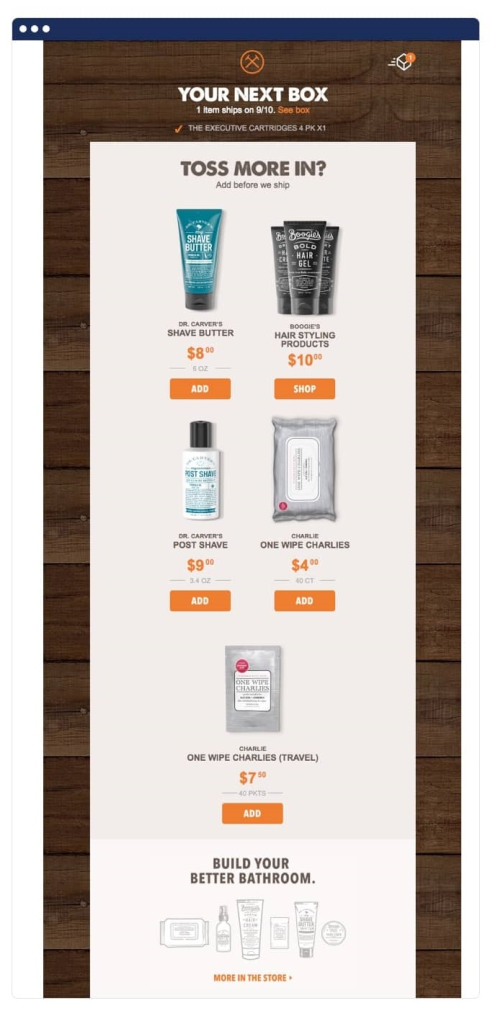
One of the strongest elements of this Cross-Sell Flow is the clarity of the messaging.
It clearly states what the user has currently ordered, and when this product is due to arrive – this is a helpful reminder that frames the rest of the cross-sell recommendations.
All of the recommended products are also highly relevant to a shave box.
It’s easy to see how an inexpensive shave butter or post-shave balm could be added to this order without much hesitation.
Below is another strategic Cross-Sell Flow from Casper:

Casper is primarily known for selling quality mattresses, so a tactical cross-sell promoting pillows is a no-brainer. It’s a match made in heaven.
The combination of mattress and pillow doesn’t need much explanation, but Casper does a great job of clearly outlining the product benefits to encourage a sale.
There are also two handy CTAs included within the Cross-Sell Flow, so if a user hasn’t committed to a pillow immediately, they have a second chance to convert further down the page.
Here’s a good example of a personalised Cross-Sell Flow from Sambag:

This is a good example of the power of personalisation in email marketing.
A profitable Cross-Sell Flow doesn’t necessarily need mind-blowing graphic design or an extensive range of different product options.
If you can effectively personalise the email to the user and recommend items that are likely to be interesting, the products can speak for themselves.
7. The ‘Upsell Flow’
While a Cross-Sell Flow is designed to sell smaller complementary items, an Upsell Flow is designed to sell a more expensive version of a product or service.
Unsurprisingly, a successful Upsell email marketing strategy can be a surefire way to supercharge your revenue and increase customer value.
An Upsell email can be triggered by various user events. You can target shoppers immediately after purchase, at the end of a trial period, or when you launch a new product.
Whenever you decide to send an Upsell Flow, your main priority is convincing a shopper to upgrade their existing purchase and buy a more valuable product.
What are the benefits of an Upsell Flow?
An effective Upsell strategy can make a serious impact on your long-term returns.
It’s not rocket science. If a customer switches to a more expensive product, plan, or subscription, you’ll increase your revenue.
Although ecommerce brands need to be careful not to push Upsell messaging too aggressively, a tactical campaign here and there can work wonders.
What makes for an effective Upsell Flow?
A successful Upsell email needs to clearly explain why an upgrade is worthwhile for the user.
Customers won’t be inclined to spend more cash for no reason, so Upsell messaging needs to be compelling, engaging and fuelled by key product information.
Here’s a tactical Upsell Flow example from Freelancer.com:

This email is packed with rational, persuasive information that’s designed to encourage a product upgrade.
Freelancer.com cleverly identifies an Upsell opportunity based on user data (i.e. a lack of recruitment for a task) and provides a promising solution – a recruitment service.
The credibility of the recruitment service is established immediately with a statistic, key benefits are laid out in bullet points, and a clear price is included in the email.
It’s easy to see how a user would be tempted to hit the CTA and immediately upgrade their Freelancer.com membership.
Here’s another effective Upsell Flow from Grammarly:
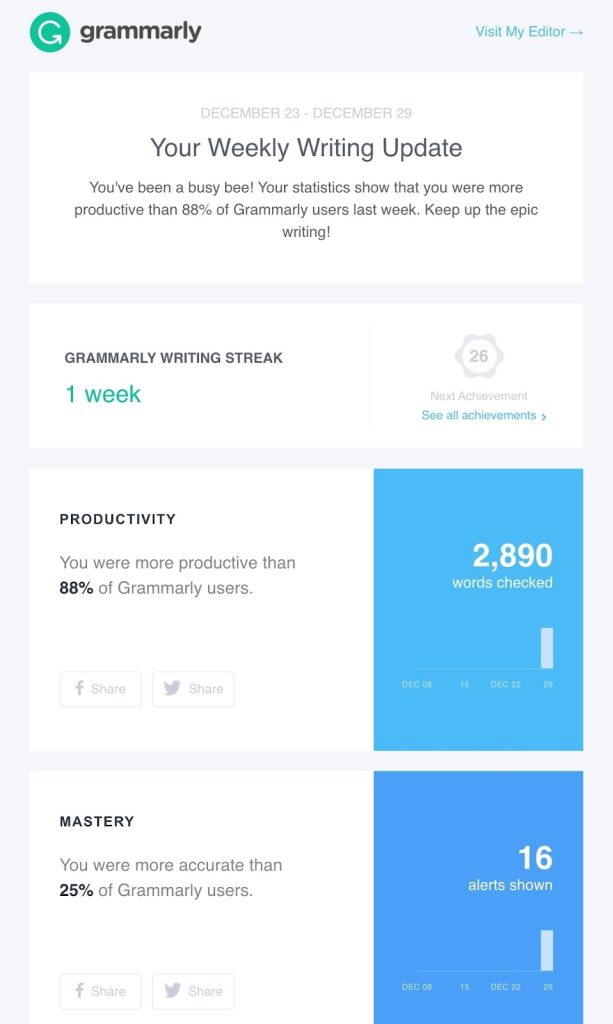
Grammarly takes a clever approach to upselling by engaging users with personalised data.
The Upsell Flow begins by showing users recent statistics about their platform usage.
Readers are sucked in by data about their productivity and performance compared with other Grammarly users, which immediately engages them.
The email then switches direction, stating that although the user has been productive, they could achieve much more with an upgraded paid Grammarly plan.
This data-led approach tells a compelling story that’s infinitely more impactful than a direct ‘upgrade now’ CTA.
Here’s a simple (but effective) Upsell message from Strava:

If you’re offering users a premium upgrade that’s genuinely superior to a standard service, sometimes it’s best to let the product speak for itself.
Strava keeps things simple with this Upsell email promoting its Premium subscription. The benefits of the premium membership are summarised neatly, and a simple CTA encourages users to upgrade.
The email doesn’t feel pushy or sales-y. It just confidently explains the perks of an upgrade and allows users to convert quickly and easily.
8. The ‘Anniversary Flow’
Personalised promotional emails are infinitely more effective than generic brand communications.
Nobody likes to feel like an anonymous subscriber in an endless mailing list. A personal touch can help to strengthen customer relationships and increase long-term profitability.
The Anniversary Flow is one of the best examples of effective personalisation.
It’s an important opportunity to recognise and reward loyal customers.
An Anniversary email can be triggered by a birthday, a subscriber milestone, or a major life event. The important thing is that the email feels bespoke and tailored to the individual.
What are the benefits of an Anniversary Flow?
A strategic Anniversary Flow can deliver a few different benefits.
Firstly, it helps to build customer relationships and improve customer retention. If users feel valued by your business, they’re more likely to stay. Simple.
However, an Anniversary message isn’t just a friendly gesture.
By including personalised offers or discount codes in an Anniversary Flow, you can encourage increased conversions while also making your loyal customers feel special.
Everybody wins!
What makes for an effective Anniversary Flow?
The key to a successful Anniversary Flow is personalisation.
You need to understand what kind of message is going to resonate with your audience, and send your email marketing at the perfect time to drive engagement and boost sales.
Here’s an engaging Anniversary Flow from Naadam:
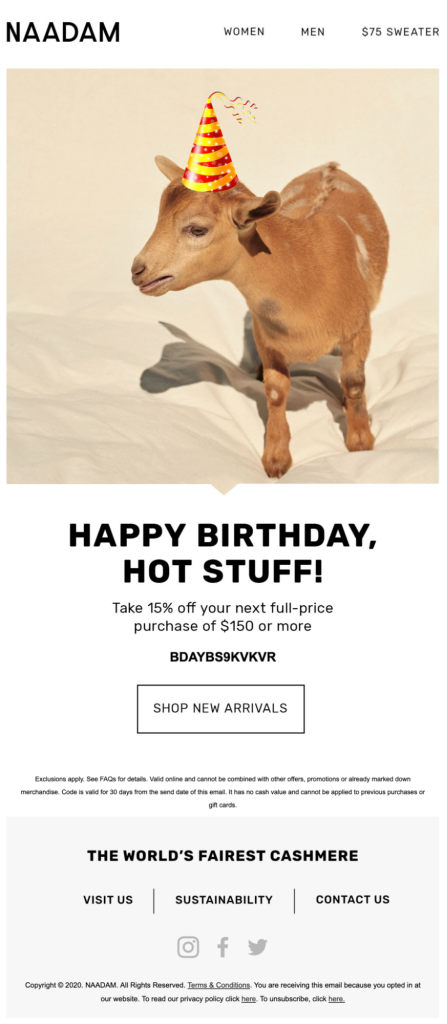
Everything about this email is positive and celebratory.
It feels like a genuine message from the brand, and the design is simple but eye-catching.
Plus, the 15% birthday discount is likely to encourage the user to click through and make a purchase. The user benefits from a saving, and Naadam generates a new sale.
Here’s a creative Anniversary Flow from Love Wellness:
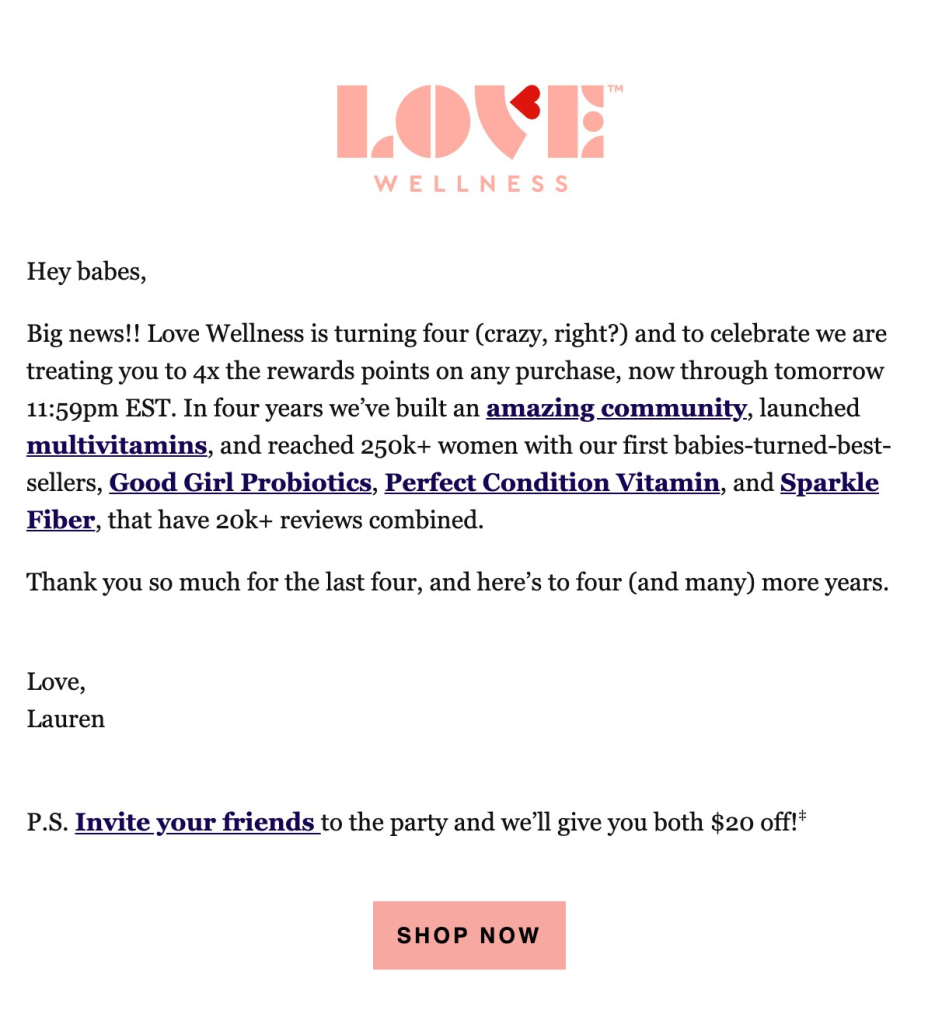
This Anniversary email achieves a lot in a short space of time.
Firstly, Love Wellness uses the opportunity to shine a light on some brand accomplishments, enhancing the reputation and credibility of the business.
Secondly, it helps the user feel like part of a community, not just a recipient of email marketing.
Finally, the Anniversary Flow is made even more persuasive by two key offers. Users can enjoy additional reward points to celebrate the business anniversary, but they can also recruit friends to unlock an additional discount,
Here’s another glowing example of an Anniversary Flow from Outdoor Voices:

This email encourages subscribers to celebrate their ‘half-birthday’, which is a unique approach to an Anniversary Flow that sets Outdoor Voices apart from the competition.
Getting creative with the user anniversaries you celebrate is a good way to capture attention and stand out in a cluttered inbox.
The inclusion of a personalised discount is also a strong incentive for a purchase.
9. The ‘Post Purchase Flow’
A Post Purchase Flow is an excellent opportunity to inject some personality and charisma into a functional communication.
Post-purchase emails are standard procedures for e-commerce businesses.
Order confirmation emails, shipping confirmation emails, product feedback requests – these are all very common, and often neglected by ecommerce businesses.
However, if you craft a creative Post Purchase Flow that stands out from the crowd, you can enhance your customer relationships and improve the user experience.
What are the benefits of a Post Purchase Flow?
The basic function of a post-purchase email is to keep customers informed.
It’s important to keep users updated on order details and shipping timings. However, with the right strategy, your post-purchase emails can achieve a lot more for your business.
A creative Post Purchase Flow can enable you to encourage repeat store visits, collect valuable user feedback, and deliver a unique customer experience.
What makes for an effective Post Purchase Flow?
Balancing creativity with basic information is vital when you’re pulling together a Post Purchase Flow.
You still need to inform users about their orders, but you also need to engage them and establish your brand personality.
Here’s a strong Post Purchase Flow from Pasta Evangelists:

This post-purchase email goes above and beyond to deliver heaps of useful information to the reader.
The order details are clear and visible, so if the reader is just interested in the basics, it’s easy for them to find what they need.
However, the content doesn’t end there. Users are also offered a referral program discount on their next order, and also given some handy advice about freezing their pasta.
This email could have easily been left as a plain and functional message. Instead, it feels highly informative and engaging, which is more likely to encourage repeat business.
Here’s another high-quality Post Purchase Flow from Ritual:

The eye-catching design of this post-purchase email helps the Ritual brand to feel more unique and interesting.
The central ‘Track Your Order’ button allows users to quickly access basic information, which is the primary purpose of the email.
However, shoppers can also access a handy referral program discount, which is a smart way to secure repeat customers. Ritual also includes user generated content from its social feeds at the bottom of the email, which is a nice touch to solidify the brand’s reputation.
Here’s a well-designed post-purchase email from Bellroy:

A post-purchase email is a fantastic time to collect customer feedback.
Since users have made a purchase very recently, they probably have fresh thoughts and opinions on your service.
Bellroy takes this opportunity to request simple feedback from customers, providing them with a 0-10 scale to rate their product.
This has a few key benefits for the business.
By requesting feedback, Bellroy makes it clear that it cares about the customer experience, which is a big plus for the brand image. Secondly, customer feedback can be incredibly useful for a business, and help ecommerce brands to genuinely improve their offering.
Thirdly, positive customer feedback can be transformed into potent social proof that can then be utilised across multiple marketing channels. Pretty handy, eh?
Email marketing has an almost infinite number of benefits for ecommerce businesses. If you’re not already utilising these tactics, now is the time to start.
These email campaigns can enable your brand to significantly improve conversion rates, consistently increase average order value, and strengthen profitable customer relationships.
If you can send these email sequences at the right time, target them to receptive audiences, and fill them with engaging content, you’ll be on track to deliver some jaw-dropping results.
